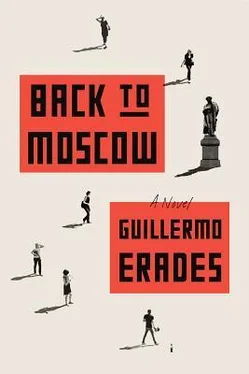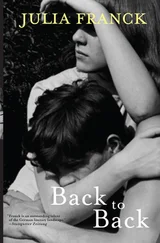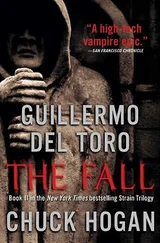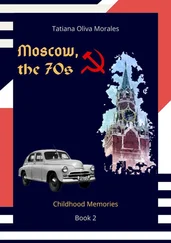One morning, a couple of days after Polina’s departure, I found myself standing in front of a poster depicting a blonde soviet woman. One hand shielding her impossibly bright blue eyes, the woman was gazing into the distance, perhaps, I thought, at the prospect of a socialist paradise. For some reason, the image reminded me of the painting of the three knights in Stepanov’s place, who also gazed into the horizon, except that the knights were carrying swords and lances, while the beautiful soviet woman carried a basket of vegetables and potatoes.
‘Comrades,’ the poster said, ‘come to the kolkhoz. Let’s produce more potatoes and vegetables. Let’s build our nation.’
I loved the naive and hopeful tone of the soviet posters — the way they portrayed a world based on work and sacrifice. I found it therapeutic to look at these images, at their beautifully faded colours, to see all those soviet men and women working together for a common goal. Women looked stunning in these posters, but not in a delicate dyevushka way — they were strong and maternal: you could not picture these women putting on make-up or complaining about the food in a café. These women were resilient, self-sufficient, forward-looking.
Where are they now? I asked myself.
I had read my share of Solzhenitsyn, and a couple of books on Russian history, and was aware of the darkest side of the soviet period. But, looking at these posters, I couldn’t help but feel both sadness and nostalgia. I felt sad and nostalgic for a past I’d never lived, a past that, as far as I knew, had never really existed, at least not as portrayed in these posters. But looking at these images full of symbolism infused me with a sense of hope.
My first contact with soviet imagery had come through Khavronina’s Russian As We Speak It , a language book Katya had given me as a present back in Amsterdam, a few weeks before we split up. It was a second-hand book with a faded blue cover that she had asked a friend to bring from Minsk.
‘I’ve been told,’ Katya said with the book in her hand, ‘this is the best manual for beginners.’ It was early in the morning and I was still in bed. Katya had already put on make-up and done her hair. I wasn’t sure if I wanted to learn Russian, not knowing whether I would get a scholarship, but I loved the drawings in the book, depicting the simple, happy, soviet lives of Pavel and Marina.
Pavel was a chemist who worked in a factory outside Moscow and Marina a doctor who worked in a children’s hospital. In lesson three, they talked about their apartment, which was plain but cosy. In lesson nine, they went to a restaurant, ordered chicken Kiev and spring salad, drank borzhomi water and then went dancing. In other lessons they went to the post office, to the countryside, to the supermarket, to the theatre. On Sundays, Pavel and Marina went to the park, where, the book said, the sun shone and birds sang.
Standing in the empty hall of the Revolution Museum, I now wondered if that was the Russia I craved — the simple and beautiful world of Pavel and Marina, and not the complicated Russia I had been thrown into.
But, as I had discovered early on in my stay, the Russia of my language book was fictional. There were no singing birds in Moscow. The birds I saw were crows or ravens — vorony, they called them — perched on the electric cables of Pushkinskaya, screeching loudly, scavenging the rubbish bins in the square, going through the leftovers outside McDonald’s.
Where had all the hope of the soviet years gone? Russians had been cheated, and, in a way, they had earned their right to be cynical. Poor old babushkas at the Revolution Museum, I thought, themselves a tragic part of the exhibits, working for a few rubles a month and then commuting to the outskirts of Moscow where they lived on a diet of beetroot, potato and mayonnaise. Poor cleaning ladies sweeping the metro, old Nadezhdas and Revmiras, whose hopes and ideals had been flushed away with the perestroika. Poor Sergey, a soviet man with no country. Poor Nadezhda Nikolaevna, scolded by a young waiter for not knowing the rules of the New Russia. Poor Lyudmila Aleksandrovna, who lived trapped in the 1970s, in her Sochi seminars, because she could not understand that, despite her admirable and firm denial, Russia was for ever changed.
The woman in the poster looked ahead with her confident regard, carrying the promise of a brighter future. In that moment, I felt a strong urge to join her and her struggle. Come with me, she seemed to be saying, stop wasting your life. I wanted to answer her call, cross the line that divides reality from historical fiction and meet her at the kolkhoz, where I would kiss her, marry her, co-suffer with her, and I would pick potatoes and vegetables all day long until my hands bled. I would do it for her, for her cause. For something to believe in.
IN DUSHECHKA, THE DARLING, Chekhov tells the story of Olga Semyonovna, a loving and gentle soul, a person who — Anton Pavlovich tells us — lives to love. The short story is set in a provincial city, and begins with Olga Semyonovna — known as Dushechka, darling, or little soul — listening attentively to the angry ramblings of Kukin, a local businessman who manages an attraction park and theatre. Kukin is whining about how the public’s bad taste and the bad weather are ruining his business. Dushechka, deeply touched by Kukin’s despair, falls for him. Soon after, they get married.
Dushechka starts helping her husband at the theatre. Now, at every social occasion, she talks at length about the theatre business, shamelessly adopting her husband’s opinions as her own. Soon, her life becomes one with that of her husband and, in her role as devoted wife, Dushechka finds purpose, perhaps even happiness.
One night, while Kukin is in Moscow on a business trip, someone knocks at the gates of Dushechka’s house. A telegram. With trembling hands, Dushechka opens the telegram and reads with astonishment that her husband has died. She is shocked but also confused, because, in a very Chekhovian detail, the telegram contains bizarre spelling mistakes. Dushechka is in pain.
Not for long though. Just three months later, while returning from church, Dushechka bumps into Pustovalov, a wood merchant, who offers her some words of consolation, death being the will of God and all that. We can see Pustovalov is hitting on the widow. Now Dushechka, always the sensitive soul, can’t stop thinking about Pustovalov. She can no longer sleep. She is in love. So they go and get married.
Dushechka is happy again, able to devote her life to her new husband. She now talks endlessly about types of wood, the price of logs and all things related to her husband’s business. Unlike her first husband Kukin, Pustovalov is a homely guy who doesn’t really like going out. When some friends suggest they go out to the theatre, Dushechka — who, as Kukin’s wife, had been the most ardent theatre devotee — now says, ‘What’s good about theatre anyway? We never go to the theatre, we are working people.’
Dushechka is a new woman because she is with a new man.
She lives happily for six years until one day in winter, after drinking hot tea, Pustovalov goes out without a hat, catches a nasty cold and, after four months of illness, dies.
Poor Dushechka. She retreats into isolation, with only the company of her cat. There is also the local veterinarian, who’s separating from his wife and comes to visit Dushechka often. Although Chekhov doesn’t really go into the details, he seems to hint that Dushechka and the vet are more than friends. We know this partly because Dushechka now bores people talking about animal diseases.
One day, to her despair, the veterinarian is posted far away and once more she is left on her own. With nobody to love, Dushechka falls into a depression. She grows old and grumpy. She no longer has any opinions. She doesn’t know what to talk about or what to think. Her heart, Chekhov tells us, is ‘as empty as her courtyard’.
Читать дальше












